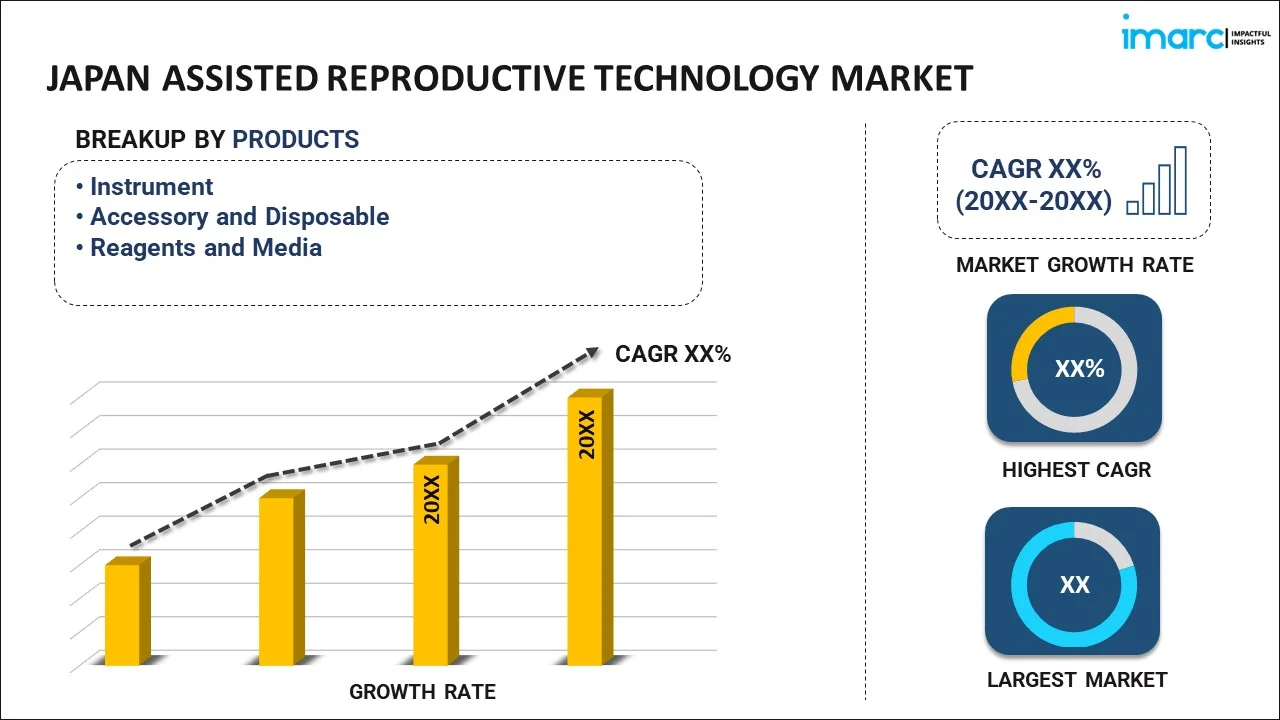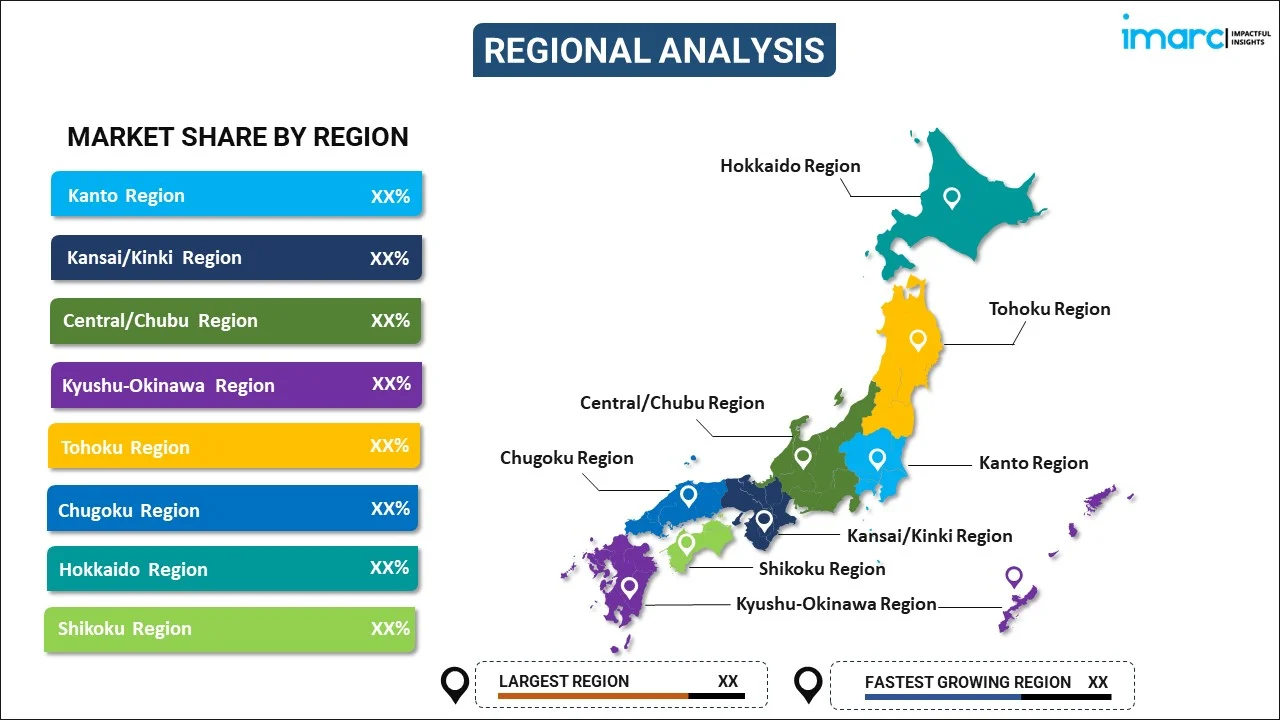
Japan Assisted Reproductive Technology Market Report by Product (Instrument, Accessory and Disposable, Reagents and Media), Type (In-Vitro Fertilization (IVF), Artificial Insemination), End Use (Fertility Clinics and Other Facilities, Hospitals and Others), and Region 2025-2033
Market Overview:
Japan assisted reproductive technology market size reached USD 3,524.7 Million in 2024. Looking forward, IMARC Group expects the market to reach USD 6,329.0 Million by 2033, exhibiting a growth rate (CAGR) of 6.7% during 2025-2033. The increasing prevalence of infertility in Japan, introduction of supportive measures by the government, recent technological advancements in ART, and rising awareness and societal acceptance of infertility treatment represent some of the key factors driving the market.
|
Report Attribute
|
Key Statistics
|
|---|---|
|
Base Year
|
2024 |
|
Forecast Years
|
2025-2033 |
|
Historical Years
|
2019-2024
|
| Market Size in 2024 | USD 3,524.7 Million |
| Market Forecast in 2033 | USD 6,329.0 Million |
| Market Growth Rate (2025-2033) | 6.7% |
Assisted reproductive technology (ART) refers to medical procedures used primarily to address infertility. It includes a variety of methodologies, such as in vitro fertilization (IVF), intracytoplasmic sperm injection (ICSI), cryopreservation of gametes or embryos, and fertility medication. ART possesses several features, like the ability to bypass physiological hurdles to fertilization, enhance gamete quality, or preserve fertility. It is comprised of medical expertise, sophisticated laboratories, legal frameworks, and ethical governance. ART is widely used by infertile couples, single individuals, and the lesbian and gay community desiring parenthood. It also finds applications in genetic disorder prevention, family balancing, surrogacy facilitation, and fertility preservation for cancer patients. ART offers a higher chance of conception, control over timing, the possibility of screening for genetic diseases, and increased knowledge about one's fertility. In addition to this, it provides several advantages, such as options for multiple pregnancy attempts and allowing same-sex couples or single parents to conceive.
Japan Assisted Reproductive Technology Market Trends:
The increasing prevalence of infertility in Japan due to lifestyle changes and the rising geriatric population represents one of the key factors propelling the market growth. Additionally, the introduction of supportive measures by the government, such as subsidizing ART procedures to encourage couples to seek treatment, is boosting the market growth. Besides this, recent technological advancements in ART that are enhancing success rates, thus boosting its adoption, are catalyzing the market growth. Furthermore, the rising awareness and social acceptance of infertility treatments are contributing to the market growth. In addition, the ongoing improvements in the regulatory framework, which provide safety assurances to potential patients, are driving the market growth. Apart from this, the increasing disposable incomes in Japan, allowing more individuals to afford often expensive treatments, such as ART, is bolstering the market growth. Moreover, the escalating investment in research and innovation by key players to develop effective treatment options for infertility is positively influencing the market growth. Along with this, the rising collaborations between Japanese and international fertility clinics to expand access to best practices and advanced treatments are supporting the market growth. In line with this, the increasing societal pressure and desire for family creation in Japan's culture is fueling the market growth. Additionally, the emergence of fertility tourism, allowing people to visit Japan for high-quality ART services, is stimulating the market growth. Furthermore, the extension of ART services to a broader demographic, including older women and single individuals, which is opening new segments, is accelerating the market growth. Besides this, recent advancements in genetic screening technologies that are making ART safer and more reliable are strengthening the market growth across the country.
Japan Assisted Reproductive Technology Market Segmentation:
IMARC Group provides an analysis of the key trends in each segment of the market, along with forecasts at the country level for 2025-2033. Our report has categorized the market based on product, type, and end use.
Product Insights:

- Instrument
- Sperm Separation System
- Cryosystem
- Incubator
- Imaging System
- Ovum Aspiration Pump
- Cabinet
- Micromanipulator
- Laser Systems
- Others
- Accessory and Disposable
- Reagents and Media
- Cryopreservation Media
- Semen Processing Media
- Ovum Processing Media
- Embryo Culture Media
The report has provided a detailed breakup and analysis of the market based on the product. This includes instrument (sperm separation system, cryosystem, incubator, imaging system, ovum aspiration pump, cabinet, micromanipulator, laser systems, and others), accessory and disposable, and reagents and media (cryopreservation media, semen processing media, ovum processing media, and embryo culture media).
Type Insights:
- In-Vitro Fertilization (IVF)
- Fresh Donor
- Frozen Donor
- Fresh Non-Donor
- Frozen Non-Donor
- Artificial Insemination
- Intrauterine Insemination
- Intracervical Insemination
- Intravaginal Insemination
- Intratubal Insemination
A detailed breakup and analysis of the market based on the type have also been provided in the report. This includes in-vitro fertilization (IVF) (fresh donor, frozen donor, fresh non-donor, and frozen non-donor) and artificial insemination (intrauterine insemination, intracervical insemination, intravaginal insemination, and intratubal insemination).
End Use Insights:
- Fertility Clinics and Other Facilities
- Hospitals and Others
The report has provided a detailed breakup and analysis of the market based on the end use. This includes fertility clinics and other facilities and hospitals and others.
Regional Insights:

- Kanto Region
- Kansai/Kinki Region
- Central/ Chubu Region
- Kyushu-Okinawa Region
- Tohoku Region
- Chugoku Region
- Hokkaido Region
- Shikoku Region
The report has also provided a comprehensive analysis of all the major regional markets, which include Kanto Region, Kansai/Kinki Region, Central/ Chubu Region, Kyushu-Okinawa Region, Tohoku Region, Chugoku Region, Hokkaido Region, and Shikoku Region.
Competitive Landscape:
The market research report has also provided a comprehensive analysis of the competitive landscape. Competitive analysis such as market structure, key player positioning, top winning strategies, competitive dashboard, and company evaluation quadrant has been covered in the report. Also, detailed profiles of all major companies have been provided.
Japan Assisted Reproductive Technology Market Report Coverage:
| Report Features | Details |
|---|---|
| Base Year of the Analysis | 2024 |
| Historical Period | 2019-2024 |
| Forecast Period | 2025-2033 |
| Units | Million USD |
| Scope of the Report | Exploration of Historical and Forecast Trends, Industry Catalysts and Challenges, Segment-Wise Historical and Predictive Market Assessment:
|
| Products Covered |
|
| Types Covered |
|
| End Uses Covered | Fertility Clinics and Other Facilities, Hospitals and Others |
| Regions Covered | Northern Vietnam, Central Vietnam, Southern Vietnam |
| Customization Scope | 10% Free Customization |
| Post-Sale Analyst Support | 10-12 Weeks |
| Delivery Format | PDF and Excel through Email (We can also provide the editable version of the report in PPT/Word format on special request) |
Key Questions Answered in This Report:
- How has the Japan assisted reproductive technology market performed so far and how will it perform in the coming years?
- What has been the impact of COVID-19 on the Japan assisted reproductive technology market?
- What is the breakup of the Japan assisted reproductive technology market on the basis of product?
- What is the breakup of the Japan assisted reproductive technology market on the basis of type?
- What is the breakup of the Japan assisted reproductive technology market on the basis of end use?
- What are the various stages in the value chain of the Japan assisted reproductive technology market?
- What are the key driving factors and challenges in the Japan assisted reproductive technology?
- What is the structure of the Japan assisted reproductive technology market and who are the key players?
- What is the degree of competition in the Japan assisted reproductive technology market?
Key Benefits for Stakeholders:
- IMARC’s industry report offers a comprehensive quantitative analysis of various market segments, historical and current market trends, market forecasts, and dynamics of the Japan assisted reproductive technology market from 2019-2033.
- The research report provides the latest information on the market drivers, challenges, and opportunities in the Japan assisted reproductive technology market.
- Porter's five forces analysis assist stakeholders in assessing the impact of new entrants, competitive rivalry, supplier power, buyer power, and the threat of substitution. It helps stakeholders to analyze the level of competition within the Japan assisted reproductive technology industry and its attractiveness.
- Competitive landscape allows stakeholders to understand their competitive environment and provides an insight into the current positions of key players in the market.
Need more help?
- Speak to our experienced analysts for insights on the current market scenarios.
- Include additional segments and countries to customize the report as per your requirement.
- Gain an unparalleled competitive advantage in your domain by understanding how to utilize the report and positively impacting your operations and revenue.
- For further assistance, please connect with our analysts.
 Inquire Before Buying
Inquire Before Buying
 Speak to an Analyst
Speak to an Analyst
 Request Brochure
Request Brochure
 Request Customization
Request Customization




.webp)




.webp)












